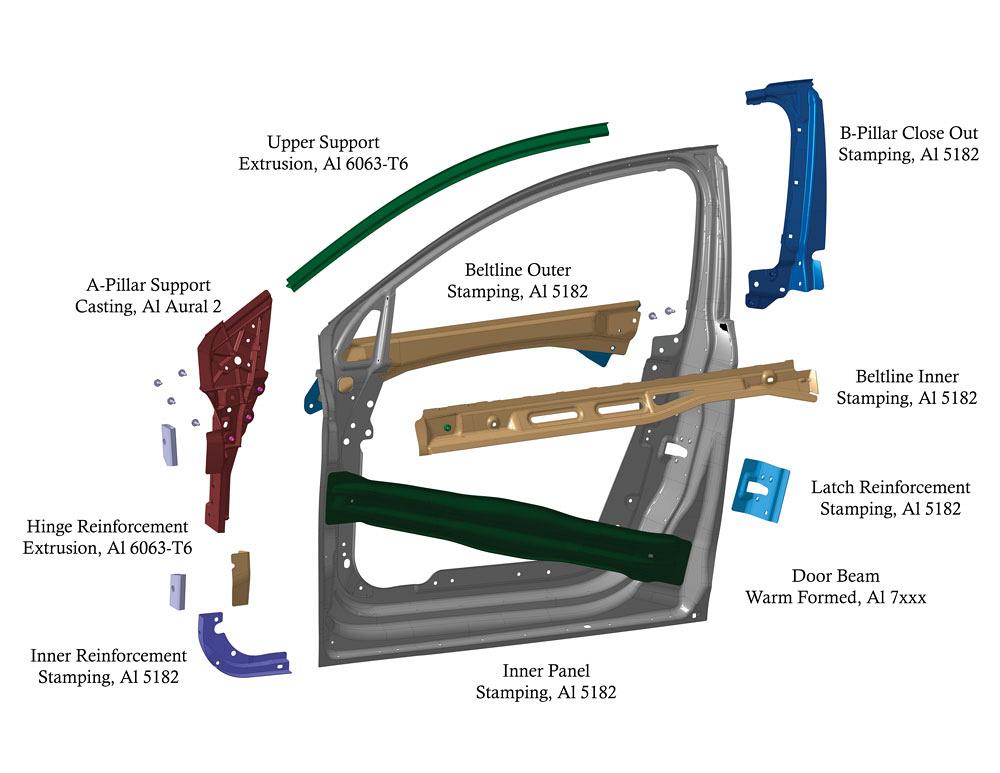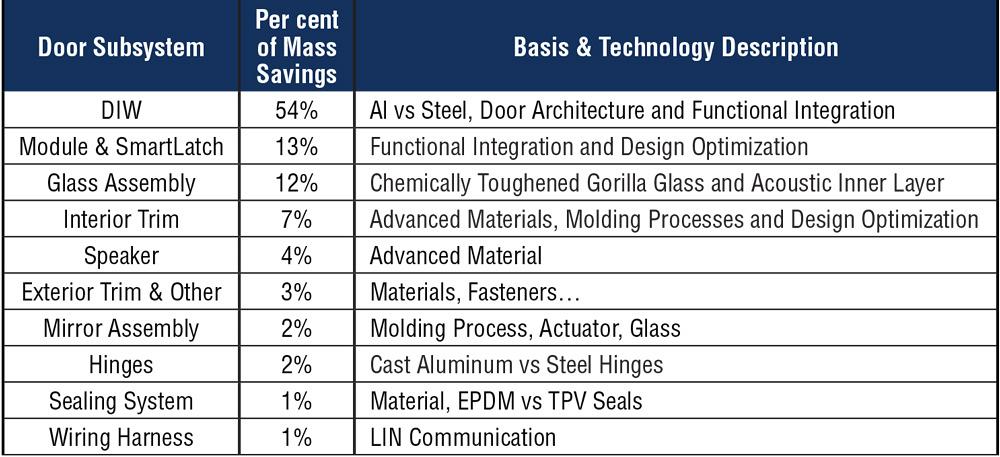Editor
- FMA
- The Fabricator
- FABTECH
- Canadian Metalworking
Magna unveils ultralight door module
Design achieves a 42.5 per cent mass savings
- By Rob Colman
- February 9, 2017
- Article
- Fabricating
Magna International Inc., in cooperation with the U.S. Department of Energy (DOE) and partners FCA US and Grupo Antolin, announced it has developed a new, ultralight door architecture that achieves a 42.5 per cent mass savings compared to an average current production door. The announcement was made at the 2017 North American International Auto Show in Detroit.
Magna has been quite active in the development of lightweighting solutions for the auto industry. The company’s development of two multimaterial lightweight vehicle (MMLV) concepts (in cooperation with the U.S. DOE and in partnership with Ford Motor Co.) was particularly interesting. In its Mach II design, a magnesium- and carbon fibre-intensive model, the team was able to realise a 51 per cent lighter vehicle than the base model the concept was based on.
However, that concept car isn’t particularly viable in the near future because of formability challenges with magnesium and corrosion issues, among others (for full details on the project, check out the April 2016 issue of Canadian Fabricating & Welding).
This door module concept, however, could be ready for production as early as 2020 as it relies on existing technologies that have simply been optimized for this design.
“We always thought that we would take a look at doors,” said Ian Simmons, vice president of business development, R&D, Magna International. “They have typically been designed by the OEMs, and we felt that we could bring a fresh-eyed approach to them, really going back to geometry and physics, looking at the new materials available, and the manufacturing processes that are out there.”
Magna's advanced engineering team was given the task. This was a collaborative effort between the company's corporate R&D and various Magna product groups. The team took less than 10 months to develop the concept, while keeping the cost within accepted industry parameters and providing a concept that applies to approximately 70 per cent of the light-vehicle market.
A big part of the savings in the design was the door-in-white portion of the module, which is made of aluminum.
“In terms of weight savings, it accounted for 54 per cent of that,” said Simmons. “It is slightly thinner than the earlier (Mach I) MMLV design. We have used some lightweight aluminum die castings for production, and a unique approach to the hinges. The hinges have typically been made of steel but are now aluminum. We were able to include reinforcement of the hinges on the A pillar side as well. We really took every application and optimized it for mass, while still making sure it met all the functional requirements.”
The door architecture in general is quite unique and includes a bolt-in beltline reinforcement and integrated door module. See the image included here of the door-in-white assembly for the details.
A key innovation associated with the development of the ultralight door was the integration of Magna's SmartLatch™ electronic latch system. This eliminated the need for mechanical hardware and enabled the development of a unique carrier module with integrated glass guides and lift capability of a lightweight hybrid glass laminate, an industry first.
“The SmartLatch we used in this design is a next-generation version, so there is even a small mass reduction compared to the version of the technology introduced to the industry last year,” noted Simmons.
Grupo Antolin provided its know-how in the design and manufacture of interior trim components to contribute to the significant mass reduction. The application of advanced moulding technologies and polymers contributed approximately 7 per cent to the total mass reduction.
The glass used in the assembly is a Corning-developed Gorilla Glass that also reduces the mass of the assembly substantially.
The ultralight door development included intensive simulation efforts, passing all safety and durability testing in the process. The next steps include manufacturing full-scale prototype door assemblies, performance tests, and safety tests to validate the design, with the goal of being available for use in production vehicles by the fall of 2020.
The FCA US engineering team has been an integral part of the design and development of the ultralight door, providing engineering collaboration to confirm compatibility with existing assembly operations as well as CAE durability, fatigue, and safety analysis. FCA US plans to conduct testing of prototype door assemblies and full vehicles to validate the results of the predictive simulation.
“For us, the attraction of this project is mass savings, and in the process we beat the DOE target by 50 per cent. We were also interested in pricing relative to volume,” said Simmons. “We wanted a high-volume solution that gave us the opportunity to talk to multiple OEMs about introducing this relatively quickly, whether they want to integrate it as a door in an existing architecture or as part of a new architecture.”
About the Author

Rob Colman
1154 Warden Avenue
Toronto, M1R 0A1 Canada
905-235-0471
Robert Colman has worked as a writer and editor for more than 25 years, covering the needs of a variety of trades. He has been dedicated to the metalworking industry for the past 13 years, serving as editor for Metalworking Production & Purchasing (MP&P) and, since January 2016, the editor of Canadian Fabricating & Welding. He graduated with a B.A. degree from McGill University and a Master’s degree from UBC.
subscribe now


Keep up to date with the latest news, events, and technology for all things metal from our pair of monthly magazines written specifically for Canadian manufacturers!
Start Your Free Subscription- Trending Articles
BlueForge Alliance partners with Nuts, Bolts & Thingamajigs to develop Submarine Manufacturing Camps

Portable system becomes hot tech in heat treatment

Orbital tube welding webinar to be held April 23

Cidan Machinery Metal Expo 2024 to be held in Georgia May 1-2

Corrosion-inhibiting coating can be peeled off after use

- Industry Events
MME Winnipeg
- April 30, 2024
- Winnipeg, ON Canada
CTMA Economic Uncertainty: Helping You Navigate Windsor Seminar
- April 30, 2024
- Windsor, ON Canada
CTMA Economic Uncertainty: Helping You Navigate Kitchener Seminar
- May 2, 2024
- Kitchener, ON Canada
Automate 2024
- May 6 - 9, 2024
- Chicago, IL
ANCA Open House
- May 7 - 8, 2024
- Wixom, MI

















